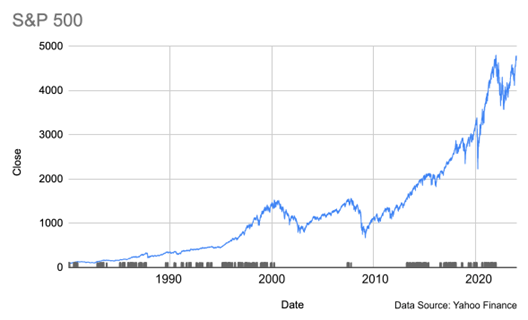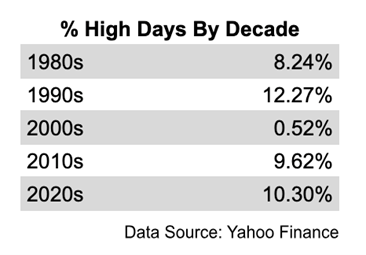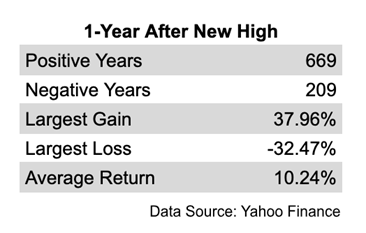Blog
Check out our latest market updates and important financial alerts

The S&P 500 Just Reached a New All-Time High - Now What?
After more than two years, the S&P 500 officially closed at a fresh all time high on Friday, its first since January 3, 2022. This snaps a streak of 512 trading days where the Index remained underwater, which included a bear market with a drawdown of over 25%.
To get to this point, we’ve had to get through multi-decade high inflation, aggressive Fed rate hikes, heightened geopolitical risks, and recessionary fears. It’s been a rollercoaster, but with major indices rallying in recent months, many are wondering what comes next. Can markets continue to run higher, or do new highs increase the likelihood of a pullback?
Two years seems like a long time to reach a new peak, but it’s important to understand that it’s normal for markets to trade underwater for extended periods of time. Looking back to 1980, the S&P 500 has only reached a true new all time high 7.91% of the time, meaning it was in a drawdown the other 92.09% of the time. This may be hard to believe with how much the Index has grown since the 80s, but the data shows approximately 9 out of 10 trading days are spent below high levels.
When markets do reach new highs, it tends to happen in clusters. Here’s a chart of the S&P 500 going back to January 1, 1980, with the gray marks at the bottom of the graph representing days where the Index closed at a new high.

Here’s what the numbers look like by decade:

The 80s and 90s are among one of the strongest bull markets in US history. While those decades certainly look more favorable than the 2000s, the S&P 500 still only reached a new high level less than 10% of the time over the twenty year period. Digging even deeper, there were 15 years with 0 all time highs, which means one out of every three years markets never saw a new high point. The best year in this timeframe was 1995, with 77 total new highs set (30.56% of days for the year). So even in the strongest years, a majority of the time is spent submerged.
Understanding new highs tend to cluster together, let’s take a look at what happens to markets over the next year after closing at a fresh high level. Since the beginning of 1980, there have been 878 trading days where the S&P reached a new peak (and 10,227 days where the Index was underwater). Here is what the numbers look like one year in the future after those new highs:

Markets were higher one year after setting a new high 76% of the time, which is inline with the average percent of positive years for the S&P 500 as a whole over the long-run. The average gain of 10.24% coming off new highs is largely on par with the average annual return of the Index for all years over that period as well.
This is why it can be so difficult to be patient as an investor at times. Returns can clump together, and there can be long stretches that feel like you’re stuck waiting for the tide to rise. Just remember, it’s normal for markets to be trading below new highs. The good news is over time they tend to move higher (see the chart for the S&P 500 since 1980 above).
So, what can we expect from markets from here?
The reality is, nobody knows exactly what comes next. The data shows us that markets are generally no better or worse than average after setting a new high water mark. While that maybe isn’t as exciting as reading the “experts” predictions, it’s more valuable knowledge in practice. There are numerous expert predictions made every single day, and most of them end up being wrong. Nobody has a crystal ball that can look into the future (nobody could have fathomed exactly how the past few years played out ahead of time).
What we can do is design a plan and strategy that we feel comfortable with regardless of what the next day, week, month, and year looks like. Market conditions are ever changing, ebbing and flowing with new information coming out constantly. While we can’t predict the markets every exact move, we can control how we react to the inevitable unforeseen conditions as we move forward.
It’s also important to remember that oftentimes as a prudent investor, the S&P 500 represents just a piece of a more broadly diversified portfolio. While large-cap US stock indices are now at new highs, many other asset classes are still clawing their way back from the losses experienced in 2022. Developed international stocks, small-cap US stocks, aggregate US bonds, and emerging markets are still 5%, 10%, 11%, and 22% below their highs respectively. Just because news headlines are saying “markets” are at a new high, it doesn’t always mean the same will be true for your portfolio. In these instances, being smartly diversified can be frustrating. But we have to look past the short-term headaches and focus on the long-term benefits, something we will dive into in upcoming posts.
Disclosure:
Winnow Wealth, LLC (“Winnow Wealth”) is a Registered Investment Adviser.
The information presented is not investment advice – it is for educational purposes only and is not an offer or solicitation for the sale or purchase of any securities or investment advisory services. Investments involve risk and are not guaranteed. Be sure to consult with a qualified financial adviser when making investment decisions.
This content is intended to provide general information about Winnow Wealth. It is not intended to offer or deliver investment advice in any way. Information regarding investment services are provided solely to gain an understanding of our investment philosophy, our strategies and to be able to contact us for further information.
All information has been obtained from sources believed to be reliable, but its accuracy is not guaranteed. There is no representation or warranty as to the current accuracy, reliability or completeness of, nor liability for, decisions based on such information and it should not be relied on as such.
The views expressed in this commentary are subject to change based on market and other conditions. These documents may contain certain statements that may be deemed forward‐looking statements. Please note that any such statements are not guarantees of any future performance and actual results or developments may differ materially from those projected. Any projections, market outlooks, or estimates are based upon certain assumptions and should not be construed as indicative of actual events that will occur.
Past performance is no guarantee of future returns.
Different types of investments involve varying degrees of risk. Therefore, it should not be assumed that future performance of any specific investment or investment strategy will be profitable.
Additional Important Disclosures may be found in the Winnow Wealth Form ADV Part 2A which we will provide upon request.
Investment advisory services also offered through Brookstone Wealth Advisors (BWA), a registered investment advisor. Winnow Wealth & BWA are independent of each other.

Copyright © 2024 Winnow Wealth, LLC
Winnow Wealth, LLC (“Winnow Wealth”) is a Registered Investment Advisor (“RIA”), located in the State of Texas. Winnow Wealth provides investment advisory and related services for clients nationally. Winnow Wealth will maintain all applicable registration and licenses as required by the various states in which Winnow Wealth conducts business, as applicable. Winnow Wealth renders individualized responses to persons in a particular state only after complying with all regulatory requirements, or pursuant to an applicable state exemption or exclusion. Investment advisory services also offered through Brookstone Wealth Advisors (BWA), a registered investment advisor. Winnow Wealth & BWA are independent of each other.

